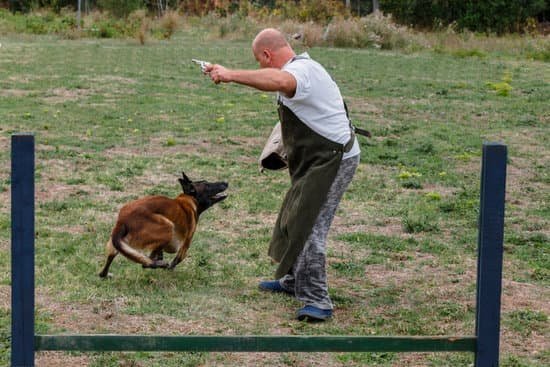Are you struggling with a dog that keeps running out the door? If so, you’re not alone. Many dog owners face this frustrating behavior from their pets, but the good news is that it can be trained. In this article, we’ll explore how to train your dog not to run out the door using effective and humane methods. From understanding the underlying reasons for this behavior to implementing training techniques, we’ve got you covered.
One of the most important aspects of addressing this issue is understanding why dogs have the tendency to bolt out the door in the first place. By delving into their natural instincts and behaviors, we can better comprehend what drives them to engage in such behavior. Understanding these motives is crucial for devising an effective training plan that works with your dog’s instincts rather than against them.
In addition to gaining insight into your dog’s behavior, setting up physical and visual barriers can make a significant difference in preventing them from running out the door. Establishing boundaries is key in creating a safe and controlled environment for your canine companion. Through leash training, positive reinforcement, consistency, and other methods, we’ll help you address this common issue and enhance safety for both you and your beloved pet.
Establishing Boundaries
When it comes to training your dog not to run out the door, one important aspect is establishing boundaries through physical and visual barriers. By setting up these barriers, you can create a clear distinction for your dog between the indoors and outdoors, making it easier for them to understand where they are allowed to go. There are several effective methods for setting up these boundaries that can help prevent your dog from running out the door unexpectedly.
One way to establish physical barriers is by installing baby gates or pet gates in doorways or entrance areas. These gates can serve as a visual reminder for your dog that they are not allowed to cross that boundary without permission. Additionally, using visual cues such as colorful tape or stickers on the floor near the doorway can also signal to your dog that they should not move past that point.
Another effective method for setting up boundaries is using training aids such as indoor pet fences or electronic pet containment systems. These tools can provide a clear and safe boundary for your dog, reinforcing the idea that they should not go beyond a certain point without guidance.
Additionally, incorporating visual barriers such as curtains or blinds on windows near the door can help minimize distractions for your dog and reduce their temptation to run out the door. By combining physical and visual barriers, you can effectively train your dog not to run out the door and create a safe environment for them indoors.
| Training Method | Description |
|---|---|
| Baby Gates | Gates installed in doorways or entrance areas as a visual reminder for dogs. |
| Indoor Pet Fences/Electronic Containment Systems | Tools providing a safe boundary for dogs, reinforcing the idea of not going beyond a certain point without guidance. |
| Visual Barriers (Curtains or Blinds) | Minimize distractions and reduce temptation for dogs to run out the door. |
Leash Training
Training your dog to wait at the door is an essential part of preventing them from running out when it’s open. This behavior can be dangerous for your pet and stressful for you as the owner, but with consistent training, you can teach your dog to stay put until given the command to exit. Here are some tips on how to train your dog not to run out the door:
First, start by teaching your dog basic obedience commands such as “sit” and “stay.” These commands are essential for leash training and will help your dog understand what is expected of them at the door.
Next, use a leash to guide your dog to the door and practice having them sit and stay while you open it. Start with short periods of time and gradually increase the duration as your dog becomes more comfortable with this exercise.
It’s important to use positive reinforcement during this training process. Whenever your dog successfully waits at the door without running out, reward them with treats and praise. This will help reinforce the desired behavior and make it more likely that they will continue to wait in the future.
| Tips for Leash Training | Benefits |
|---|---|
| Teach basic obedience commands like sit and stay | Helps create a foundation for leash training |
| Use a leash to guide your dog to the door | Provides guidance and control during training |
| Utilize positive reinforcement with treats and praise | Encourages good behavior at the door |
By following these steps, you can effectively train your dog not to run out of the door. Remember that consistency is key, so be patient and persistent in your training efforts. If you encounter challenges or feel overwhelmed, don’t hesitate to seek guidance from a professional trainer or behaviorist who can provide additional support.
Positive Reinforcement
One effective method for training your dog not to run out the door is through positive reinforcement. This involves using treats and rewards to encourage good behavior and teach your dog to stay inside when the door is open. Positive reinforcement helps create a strong association between staying indoors and receiving a reward, making it more likely that your dog will repeat the desired behavior.
To start, choose a tasty treat that your dog loves and is motivated by. When you’re at the door, give the command for your dog to stay or wait, and then open the door slightly. If your dog remains inside without attempting to run out, immediately reward them with a treat and verbal praise. Consistency is key in this process – be sure to use the same command and reward system every time you practice this training exercise.
It’s important to note that while treats can be highly motivating for most dogs, every pet is different. Some dogs may respond better to other types of rewards, such as playtime with their favorite toy or even just verbal praise. Experiment with different rewards to see what works best for your individual dog when learning how to train dog not to run out door.
Consistency Is Key
Consistency is crucial when it comes to training your dog not to run out the door. Without a clear and predictable routine, your furry friend may struggle to understand what is expected of them. By implementing a training schedule, you can establish a sense of structure and reinforce positive behaviors over time.
To effectively train your dog not to run out the door, consider incorporating the following elements into your training schedule:
- Regular Training Sessions: Set aside dedicated time each day to work on door manners with your dog. This could involve practicing leash training, reinforcing commands, or engaging in other activities that promote good behavior around the doorway.
- Consistent Reinforcement: Be consistent in your approach to rewarding and redirecting your dog’s behavior. Use positive reinforcement techniques, such as offering treats or praise when they successfully wait at the door, to encourage the desired actions.
- Repetition and Practice: Repetition is key to solidifying new behaviors. Incorporate door-related exercises into your daily routine and provide ample opportunities for your dog to practice waiting at the threshold.
By implementing a structured training schedule that includes regular sessions, consistent reinforcement, and ample practice opportunities, you can effectively teach your dog not to run out the door.
Remember that every dog is unique, so it’s important to tailor your training approach to suit their individual needs and personality. With patience, dedication, and a well-planned training schedule, you can help your canine companion understand and follow the rules around doorways more effectively. If you are willing t get there in no time then contact us today.
Redirecting Attention
To prevent your dog from running out the door, it’s essential to redirect their attention to engaging toys and activities inside. By providing stimulating distractions, you can help keep your dog focused on indoor fun and reduce their desire to bolt outside.
One effective way to redirect your dog’s attention is by using interactive toys that stimulate their mind and keep them engaged. Consider using puzzle toys or treat-dispensing toys that require your dog to work for their reward. This not only keeps them occupied, but also helps alleviate boredom, which can be a common cause of trying to escape outside.
In addition to interactive toys, incorporating daily playtime and mental stimulation activities can also help redirect your dog’s focus indoors. Whether it’s playing fetch, engaging in obedience training sessions, or setting up indoor obstacle courses, keeping your dog physically and mentally active can discourage them from seeking excitement outside the door.
Furthermore, consider providing long-lasting chews or food puzzles to keep your dog occupied when you’re unable to actively engage with them. These types of activities can be particularly helpful when you need to focus on tasks around the house while ensuring that your dog remains content and entertained indoors. Through consistent redirection of attention with engaging toys and activities inside, you’ll be able to train your dog not to run out the door effectively.
- Use interactive toys such as puzzle toys and treat-dispensing toys
- Incorporate daily playtime and mental stimulation activities
- Provide long-lasting chews or food puzzles for independent entertainment
Addressing Fear and Anxiety
Many dogs run out the door due to fear and anxiety, which can be a challenging behavior to address. It is important for dog owners to understand the underlying reasons for their dog’s anxious behavior in order to effectively address it. By using calming techniques, dog owners can help their nervous dogs feel more secure and less likely to bolt out the door.
One effective calming technique for nervous dogs is the use of pheromone diffusers or sprays. Products such as Adaptil or Feliway release synthetic pheromones that mimic those produced by nursing mothers, which can have a calming effect on dogs. These products can be plugged in near the door or sprayed on surfaces where the dog often spends time.
Furthermore, creating a safe space for the dog inside the home can also help reduce anxiety and prevent them from running out the door. This safe space could be a cozy crate or bed placed away from high traffic areas, where the dog can retreat when feeling overwhelmed.
By providing a designated area where they feel secure, nervous dogs are less likely to seek an escape route through the door. Owners should also ensure that this safe space is stocked with familiar toys and comforting items to further soothe their anxious pets.
In addition, implementing relaxation exercises such as deep breathing and massage can help calm a nervous dog and reduce their urge to run out the door. For example, gently massaging your dog’s ears or performing slow, rhythmic strokes along their body can release tension and promote relaxation.
Pairing these calming techniques with positive reinforcement will also help nervous dogs associate feelings of security with being inside, ultimately reducing their desire to escape through the door. With patience and consistency in using these calming techniques, dog owners can effectively train their anxious pets not to run out the door.
Safety Precautions
When it comes to preventing your dog from running out the door, safety precautions are incredibly important. No matter how well-trained your dog may be, there is always a potential for escapes and emergencies. It’s essential to be prepared for any unforeseen circumstances to ensure the safety of your pet.
Secure Fencing and Gates
One of the most critical safety precautions is to ensure that your fencing and gates are secure. Regularly inspect them for any signs of wear and tear, and make necessary repairs promptly. Consider adding additional locks or latches to gates for extra security, especially if you have a particularly clever or determined escape artist.
ID Tags and Microchipping
Even with all the preventative measures in place, there is still a chance that your dog could manage to escape. In such cases, having updated identification tags with your contact information is crucial for a safe return. Additionally, consider microchipping your dog, as it provides permanent identification that cannot be lost or removed.
Emergency Kit
Prepare an emergency kit specifically for your dog in case of an escape or other unforeseen events. Include items such as a current photo of your pet, medical records, contact information for local shelters and veterinary clinics, as well as familiar items like bedding or toys to help comfort them in unfamiliar surroundings.
By taking these safety precautions and being prepared for potential escapes and emergencies, you can ensure the security and well-being of your beloved pet. While it’s crucial to focus on training techniques to prevent door dashing behavior, being proactive in preparing for worst-case scenarios will ultimately provide peace of mind for you as a responsible pet owner.
Seeking Professional Help
In conclusion, training your dog not to run out the door requires patience, consistency, and the right techniques. Understanding why dogs exhibit this behavior is the first step in addressing it effectively. Setting up physical and visual barriers, along with leash training and positive reinforcement, can help establish boundaries and encourage good behavior.
Consistency is key when it comes to training your dog not to run out the door. Implementing a training schedule and providing engaging toys and activities inside can help redirect your dog’s attention. It’s also important to address any fear or anxiety that may be driving your dog’s behavior, as well as prepare for potential escapes and emergencies with safety precautions.
If you find that you are struggling to train your dog not to run out the door despite your best efforts, seeking professional help from a trainer or behaviorist may be necessary. They can provide expert guidance and tailored solutions for your specific situation, helping you and your furry friend overcome this challenging behavior. Remember that with patience, dedication, and the right support, it is possible to successfully train your dog not to run out the door.
Frequently Asked Questions
How Do I Stop My Dog From Running Out the Door?
One way to stop your dog from running out the door is to teach them a solid “wait” or “stay” command. Practice this by rewarding them for staying put when the door opens.
How Do I Stop My Dog From Dashing the Door?
To prevent your dog from dashing the door, you can work on their impulse control. Use positive reinforcement to reward them for calm behavior near the door and gradually increase distractions.
How Do I Train My Dog Not to Run Out?
Training your dog not to run out involves teaching them basic obedience commands like “sit,” “stay,” and “come.” Practice these commands consistently in various situations, including near open doors, to reinforce good behavior.

Welcome to the blog! I am a professional dog trainer and have been working with dogs for many years. In this blog, I will be discussing various topics related to dog training, including tips, tricks, and advice. I hope you find this information helpful and informative. Thanks for reading!





